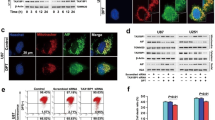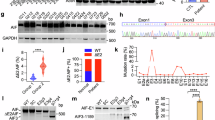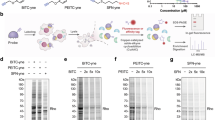Abstract
Mitochondrial dysfunction and release of pro-apoptotic factors such as cytochrome c or apoptosis-inducing factor (AIF) from mitochondria are key features of neuronal cell death. The precise mechanisms of how these proteins are released from mitochondria and their particular role in neuronal cell death signaling are however largely unknown. Here, we demonstrate by fluorescence video microscopy that 8–10 h after induction of glutamate toxicity, AIF rapidly translocates from mitochondria to the nucleus and induces nuclear fragmentation and cell death within only a few minutes. This markedly fast translocation of AIF to the nucleus is preceded by increasing translocation of the pro-apoptotic bcl-2 family member Bid (BH3-interacting domain death agonist) to mitochondria, perinuclear accumulation of Bid-loaded mitochondria, and loss of mitochondrial membrane integrity. A small molecule Bid inhibitor preserved mitochondrial membrane potential, prevented nuclear translocation of AIF, and abrogated glutamate-induced neuronal cell death, as shown by experiments using Bid small interfering RNA (siRNA). Cell death induced by truncated Bid was inhibited by AIF siRNA, indicating that caspase-independent AIF signaling is the main pathway through which Bid mediates cell death. This was further supported by experiments showing that although caspase-3 was activated, specific caspase-3 inhibition did not protect neuronal cells against glutamate toxicity. In conclusion, Bid-mediated mitochondrial release of AIF followed by rapid nuclear translocation is a major mechanism of glutamate-induced neuronal death.
Similar content being viewed by others
Log in or create a free account to read this content
Gain free access to this article, as well as selected content from this journal and more on nature.com
or
Abbreviations
- AIF:
-
apoptosis-inducing factor
- ANOVA:
-
analysis of variance
- CCCP:
-
carbonyl cyanide m-chlorophenylhydrazone
- FACS:
-
fluorescent-activated cell sorting
- FITC:
-
fluorescein isothiocyanate
- GFP:
-
green fluorescent protein
- Hq:
-
harlequin
- JC-1:
-
5,5′,6,6′-tetrachloro-1,1′,3,3′-tetraethylbenzimidazolyl-carbocyanine iodide
- MTT:
-
3-(4,5-dimethylthiazol-2-yl)-2,5-diphenyltetrazolium bromide
- PARP:
-
poly-(ADP-ribose)-polymerase-1
- RT-PCR:
-
reverse transcription-PCR
- siRNA:
-
small interfering RNA
- Smac/Diablo:
-
second mitochondria-derived activator of caspase/direct IAP binding protein with low pI
- STS:
-
staurosporine
- tBid:
-
truncated Bid
References
Mattson MP, Duan W, Pedersen WA, Culmsee C . Neurodegenerative disorders and ischemic brain diseases. Apoptosis 2001; 6: 69–81.
Culmsee C, Landshamer S . Molecular insights into mechanisms of the cell death program: role in the progression of neurodegenerative disorders. Curr Alzheimer Res 2006; 3: 269–283.
Polster BM, Fiskum G . Mitochondrial mechanisms of neural cell apoptosis. J Neurochem 2004; 90: 1281–1289.
Yuan J, Yankner BA . Apoptosis in the nervous system. Nature 2000; 407: 802–809.
Zhu C, Qiu L, Wang X, Hallin U, Cande C, Kroemer G et al. Involvement of apoptosis-inducing factor in neuronal death after hypoxia–ischemia in the neonatal rat brain. J Neurochem 2003; 86: 306–317.
Zhu C, Wang X, Huang Z, Qiu L, Xu F, Vahsen N et al. Apoptosis-inducing factor is a major contributor to neuronal loss induced by neonatal cerebral hypoxia–ischemia. Cell Death Differ 2007; 14: 775–784.
Plesnila N, Zhu C, Culmsee C, Groger M, Moskowitz MA, Blomgren K . Nuclear translocation of apoptosis-inducing factor after focal cerebral ischemia. J Cereb Blood Flow Metab 2004; 24: 458–466.
Culmsee C, Zhu C, Landshamer S, Becattini B, Wagner E, Pellecchia M et al. Apoptosis-inducing factor triggered by poly(ADP-ribose) polymerase and Bid mediates neuronal cell death after oxygen–glucose deprivation and focal cerebral ischemia. J Neurosci 2005; 25: 10262–10272.
Cheung EC, Melanson-Drapeau L, Cregan SP, Vanderluit JL, Ferguson KL, McIntosh WC et al. Apoptosis-inducing factor is a key factor in neuronal cell death propagated by BAX-dependent and BAX-independent mechanisms. J Neurosci 2005; 25: 1324–1334.
Heo K, Cho YJ, Cho KJ, Kim HW, Kim HJ, Shin HY et al. Minocycline inhibits caspase-dependent and -independent cell death pathways and is neuroprotective against hippocampal damage after treatment with kainic acid in mice. Neurosci Lett 2006; 398: 195–200.
Yu SW, Wang H, Poitras MF, Coombs C, Bowers WJ, Federoff HJ et al. Mediation of poly(ADP-ribose)polymerase-1-dependent cell death by apoptosis-inducing factor. Science 2002; 297: 259–263.
Dawson VL, Dawson TM . Deadly conversations: nuclear–mitochondrial cross-talk. J Bioenerg Biomembr 2004; 36: 287–294.
Polster BM, Basanez G, Etxebarria A, Hardwick JM, Nicholls DG . Calpain I induces cleavage and release of apoptosis-inducing factor from isolated mitochondria. J Biol Chem 2005; 280: 6447–6454.
Plesnila N, Zinkel S, Le DA, Amin-Hanjani S, Wu Y, Qiu J et al. BID mediates neuronal cell death after oxygen/glucose deprivation and focal cerebral ischemia. Proc Natl Acad Sci USA 2001; 98: 15318–15323.
Becattini B, Sareth S, Zhai D, Crowell KJ, Leone M, Reed JC et al. Targeting apoptosis via chemical design: inhibition of bid-induced cell death by small organic molecules. Chem Biol 2004; 11: 1107–1117.
Becattini B, Culmsee C, Leone M, Zhai D, Zhang X, Crowell KJ et al. Structure–activity relationships by interligand NOE-based design and synthesis of antiapoptotic compounds targeting Bid. Proc Natl Acad Sci USA 2006; 103: 12602–12606.
Culmsee C, Plesnila N . Targeting Bid to prevent programmed cell death in neurons. Biochem Soc Trans 2006; 34: 1334–1340.
Ward MW, Rehm M, Duessmann H, Kacmar S, Concannon CG, Prehn JH . Real time single cell analysis of Bid cleavage and Bid translocation during caspase-dependent and neuronal caspase-independent apoptosis. J Biol Chem 2006; 281: 5837–5844.
Konig HG, Rehm M, Gudorf D, Krajewski S, Gross A, Ward MW et al. Full length Bid is sufficient to induce apoptosis of cultured rat hippocampal neurons. BMC Cell Biol 2007; 8: 7.
Pei Y, Xing D, Gao X, Liu L, Chen T . Real-time monitoring full length bid interacting with Bax during TNF-alpha-induced apoptosis. Apoptosis 2007; 12: 1681–1690.
Frezza C, Cipolat S, Martins de Brito O, Micaroni M, Beznoussenko GV, Rudka T et al. OPA1 controls apoptotic cristae remodeling independently from mitochondrial fusion. Cell 2006; 126: 177–189.
Kim TH, Zhao Y, Ding WX, Shin JN, He X, Seo YW et al. Bid-cardiolipin interaction at mitochondrial contact site contributes to mitochondrial cristae reorganization and cytochrome C release. Mol Biol Cell 2004; 15: 3061–3072.
Yin XM, Luo Y, Cao G, Bai L, Pei W, Kuharsky DK et al. Bid-mediated mitochondrial pathway is critical to ischemic neuronal apoptosis and focal cerebral ischemia. J Biol Chem 2002; 277: 42074–42081.
Bermpohl D, You Z, Korsmeyer SJ, Moskowitz MA, Whalen MJ . Traumatic brain injury in mice deficient in Bid: effects on histopathology and functional outcome. J Cereb Blood Flow Metab 2006; 26: 625–633.
Susin SA, Daugas E, Ravagnan L, Samejima K, Zamzami N, Loeffler M et al. Two distinct pathways leading to nuclear apoptosis. J Exp Med 2000; 192: 571–580.
Cande C, Vahsen N, Garrido C, Kroemer G . Apoptosis-inducing factor (AIF): caspase-independent after all. Cell Death Differ 2004; 11: 591–595.
Kazhdan I, Long L, Montellano R, Cavazos DA, Marciniak RA . Targeted gene therapy for breast cancer with truncated Bid. Cancer Gene Ther 2006; 13: 141–149.
Duvezin-Caubet S, Jagasia R, Wagener J, Hofmann S, Trifunovic A, Hansson A et al. Proteolytic processing of OPA1 links mitochondrial dysfunction to alterations in mitochondrial morphology. J Biol Chem 2006; 281: 37972–37979.
Liu Y, Peterson DA, Kimura H, Schubert D . Mechanism of cellular 3-(4,5-dimethylthiazol-2-yl)-2,5-diphenyltetrazoliumbromide (MTT) reduction. J Neurochem 1997; 69: 581–593.
Culmsee C, Gerling N, Lehmann M, Nikolova-Karakashian M, Prehn JH, Mattson M et al. Nerve growth factor survival signaling in cultured hippocampal neurons is mediated through TrkA and requires the common neurotrophin receptor P75. Neuroscience 2002; 115: 1089–1108.
Acknowledgements
The authors gratefully acknowledge outstanding technical support and generation of vectors for transfection experiments by Melinda Kiss as well as additional control experiments by Markus Hofer. This work was supported in part by NIH grant HL082574 to MP.
Author information
Authors and Affiliations
Corresponding authors
Additional information
Edited by G Kroemer
Supplementary Information accompanies the paper on Cell Death and Differentiation website (http://www.nature.com/cdd)
Supplementary information
Rights and permissions
About this article
Cite this article
Landshamer, S., Hoehn, M., Barth, N. et al. Bid-induced release of AIF from mitochondria causes immediate neuronal cell death. Cell Death Differ 15, 1553–1563 (2008). https://doi.org/10.1038/cdd.2008.78
Received:
Revised:
Accepted:
Published:
Issue date:
DOI: https://doi.org/10.1038/cdd.2008.78
Keywords
This article is cited by
-
BANF1 promotes glutamate-induced apoptosis of HT-22 hippocampal neurons
Molecular Biology Reports (2023)
-
Future Perspectives of Oxytosis/Ferroptosis Research in Neurodegeneration Diseases
Cellular and Molecular Neurobiology (2023)
-
Cyclase-associated protein 2 (CAP2) controls MRTF-A localization and SRF activity in mouse embryonic fibroblasts
Scientific Reports (2021)
-
Endonuclease G promotes autophagy by suppressing mTOR signaling and activating the DNA damage response
Nature Communications (2021)
-
Cofilin1 oxidation links oxidative distress to mitochondrial demise and neuronal cell death
Cell Death & Disease (2021)



